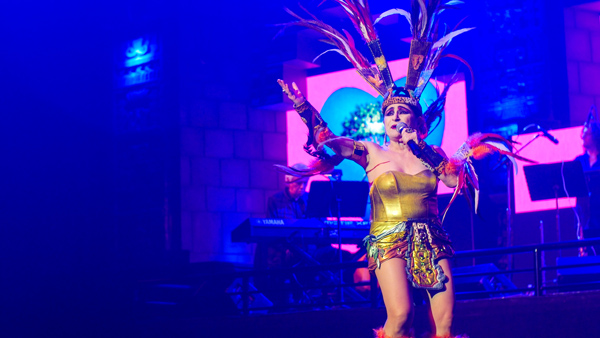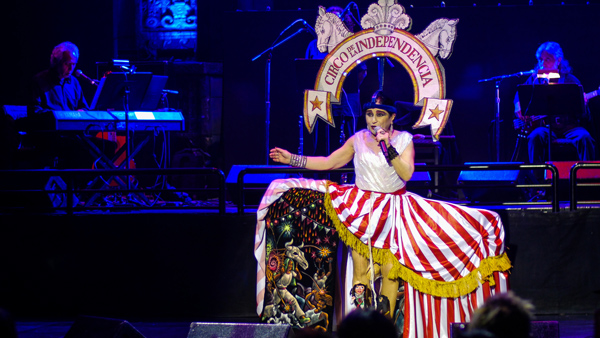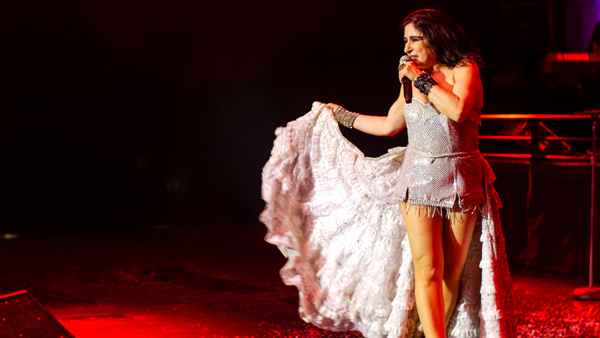On Thursday evening, when performance artist Astrid Hadad began telling a glitter-bombed, sombrero-wearing rubber chicken that everything would be okay, I remembered that there was still good in the world. The day’s news had been completely crappy, and I had ridden into the Mayan Theater on a toxic tide of gloom. I arrived to see Hadad’s show, I Am Made in Mexico, which kicks off REDCAT’S Live Art LA/LA series. Taking my place in line next to a gentle-eyed Cal State LA Critical Masculinities professor, I started grumbling that I couldn’t take three more years of this presidency.
“It’s okay,” the professor said. “There’s still art.”
“I don’t know,” I gibbered. “Art can’t save us. We haven’t hit the bottom. There’s a nuke at the bottom.”
“All right, all right,” they soothed.
We went inside. The Mayan was packed with Latinx folks wearing buzzcuts, cats-eye glasses, and pretty freakum dresses. An Anglo person with wild silver hair and harem pants declaimed about aesthetics to a crowd of black-clad philosophers. Genderqueer heartbreakers in pompadours and cap-toes flirted with the girlz in the freakums. The DTLA cocktail of dragon sleeve tats and 40’s-style wiggle skirts, muscle shirts and mascara, began to heal hurt nerves like the balm of Gilead.
Then Astrid Hadad exploded onto the stage, which was lit up with a pink pyramid and huge blue hearts.

Wearing a crown of two-foot pheasant feathers and a solid-gold onesie, Hadad wasted no time breaking out into a song-and-dance number about ancient Tenochtitlán, mother city of Mexico. Hadad is famous for her zanily liberationist cabaret shows, which are inspired by Bertolt Brecht and the Afro-Caribbean—themed Rumberas films of mid-20th c. Mexico. She channeled an ancient Mexica priestess as she sang about Mother Moon, whom our ancestors once gazed at before they were exterminated by the conquerors. Hadad then began to free associate about how, in the 16th century, the Spaniards were the “gringo imperialists of their time” who capitalized upon the exploitation and submission of other countries. “When the Spaniards saw the Aztecs committing human sacrifice and a little bit of cannibalism, they thought the Mexican people were savages,” she said, shimmying her shoulders. “But they weren’t—they were poets and sculptors and scientists and warriors.” She shrugged, trying to reconcile the complicated attributes of Latino forebears. “Also, you know, they recycled.”

Upon this observation came a rapid costume change: With the aid of burly assistants, Hadad slipped into a massive headdress made of masks and a huge pink dress with heads on its skirt. “My outfit is like the wall the Aztecs built with the skulls of sacrificed people!” she explained. This transition led into a routine about Montezuma’s irreversible blunder of submitting to Hernán Cortés c. 1519: “When the bearded men of prophecy arrived,” she sang, from the perspective of a cinquecento cacique, “the King said that they were gods. The white soldiers rode huge beasts, with fire in their hands, and their bodies covered in metal. And in that mistake we surrendered our history and remained enslaved for 300 years!” Hadad did a can-can kick and made a moue. “But there is no use in crying!”

The crowd yelled and cheered, agreeing. I looked around but couldn’t find the Critical Masculinities professor anywhere. Meanwhile, Hadad executed another swift wardrobe switcheroo into a wide-skirted silver wedding dress, as a huge disco ball dropped from the ceiling. She began singing a jingle that resembled the groovy soundtrack of The Pink Panther. “Refugees are dying!” she hollered. She opened up a hidden panel on her skirt and unfolded it as if it were a pop-up book, revealing a black-and-white mural of a graveyard, with skeletons littered upon the ground. “A lot of people suffer for the ambition of the few! Powerful people say, ‘Give me your silver and I’ll drink your blood!’” All the while Hadad pranced back and forth with her arms outstretched: “La la la la la la la!!!!”

People were boogying in the audience. Two women, close to the stage, gyrated with their hands held high and huge smiles on their faces. What is this? I wondered. A political rally? A party? A particularly fun anti-government conspiracy? As I, too, swiveled my hips, I suddenly remembered a 2011 UCLA study finding that political oppressed minorities suffering depression could heal themselves by “actively engaged in learning, talking, and praying about [discriminatory] legislation as well as protesting it.”

I resolved that “attending an Astrid Hadad concert” should be added to that Rx. It felt way better to exult as Hadad crooned her indictments for genocide than to impotently brood at home about pass-through tax deductions and de-escalation with North Korea. The crowd boiled with excitement as she changed into a blue and yellow gown with a red tree embroidered onto it. Resplendent, she brought out the glittery rubber chicken, and began to serenade it with the classic ditty known as Cucurrucucú Paloma:
Cucurrucucú, cucurrucucú, Hadad sang in a high, warbly voice.
Cucurrucucú, cucurrucucú,
Cucurrucucú, dove, don’t cry anymore

She looked at the audience, gave them a wink, and threw the wobble-headed chicken across the stage. And then she just kept dancing, because even though Hadad’s work is soaked through to the bone with tears, despair, and grief for the dispossessed, she knew what the Critical Masculinities professor had reminded me of—and what I had almost forgotten.
Courtesy REDCAT; All photos by Vanessa Crocini
For info on more upcoming performances: Live Art LA/LA series


